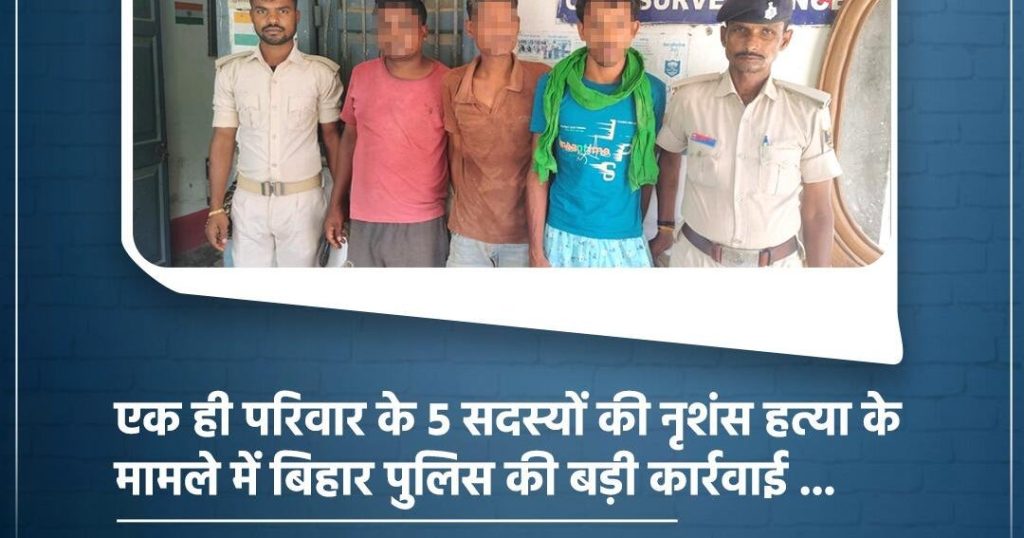In a troubling incident in the eastern Indian state of Bihar, police have apprehended three individuals linked to the gruesome murder of a family of five, who were accused of witchcraft. The victims were brutally attacked and subsequently burned by a mob in the village of Temta over the weekend. The case underscores the ongoing issue of witchcraft accusations in rural India, which often lead to deadly violence and communal unrest.
| Article Subheadings |
|---|
| 1) Victims and Circumstances of the Incident |
| 2) Police Response and Arrests |
| 3) The Survivor’s Account |
| 4) The Cultural Context of Witchcraft Accusations |
| 5) Future Implications and Government Action |
Victims and Circumstances of the Incident
The attack occurred on Sunday night in Temta village, where five family members were brutally killed. Identified as Babu Lal Oraon, 50, his 70-year-old mother Kanto Devi, along with Babu Lal’s wife and two adult children, the victims were reportedly accused of witchcraft. Such accusations often arise in response to local tragedies or illnesses, manifesting the deep-rooted superstitions prevalent in many rural communities.
The violent act followed the death of a local child who succumbed to an illness about ten days prior. On the night of the attack, the child’s brother also experienced a sudden illness, which fueled the village’s suspicion against the Oraon family. It appears that traditional beliefs regarding witchcraft led to a mob mentality among residents, culminating in the group’s decision to take law into their own hands.
Police Response and Arrests
In response to the brutal incident, local law enforcement has acted promptly. Pramod Kumar Mandal, the Deputy Inspector General in Purnea district, confirmed that three suspects have already been arrested for their involvement in the crime. Mandal stated, “We have arrested three accused so far,” emphasizing the need to address such violent responses to witchcraft allegations.
The Bihar Police have mobilized a specialized team dedicated to investigating this heinous crime, under the guidance of Superintendent of Police Sweety Sahrawat. She has assured the public that efforts are underway to apprehend all those involved. However, community fears and reluctance to cooperate have complicated these efforts, as many residents fear retribution from their neighbors if they provide assistance to law enforcement.
The Survivor’s Account
The sole survivor of the attack was the couple’s 16-year-old son. He provided police with a harrowing account of the events leading up to the violent mob assault. According to his testimony, around 50 villagers stormed their home at approximately 10 p.m., accusing his mother of practicing witchcraft. The mob wielded bladed weapons, descending upon the family without warning.
This tragic outcome raises questions about the social dynamics within the village, illustrating how quickly fear and suspicion can escalate into violence. The survivor’s story underscores the need for greater awareness and intervention in communities where such accusations can lead to fatal consequences.
The Cultural Context of Witchcraft Accusations
Witchcraft beliefs are deeply ingrained in various cultures, particularly in rural parts of India and other parts of South Asia. This incident is not isolated; reports of mob violence fueled by witchcraft accusations have emerged from different regions, showing a continuing trend that brings to light the intersection of superstition and violence.
These beliefs often root back to historical superstitions, where individuals or families are held responsible for unexplained illnesses or misfortunes. Despite several initiatives aiming to educate communities and dispel such beliefs, they persist, creating an environment where accusations can lead to mob justice. Activists and governments have been working to abolish these outdated beliefs, but change has proven to be slow.
Future Implications and Government Action
Looking ahead, the implications of this violent incident may propel government officials to take more robust action against witchcraft-related violence. Institutions and advocacy groups are calling for stricter laws that penalize mob actions and educate communities about the dangers of such beliefs. Officials have acknowledged that the fight against superstition requires comprehensive strategies that include education, legal reform, and community engagement.
As investigations proceed, the Bihar Police will grapple with the challenge of ensuring justice while fostering a safer environment for vulnerable families. This incident highlights the urgent need for sustained efforts to eliminate the underlying beliefs that give rise to such acts of violence, as well as the societal structures that allow them to occur.
| No. | Key Points |
|---|---|
| 1 | Five family members were murdered following accusations of witchcraft. |
| 2 | Authorities have arrested three suspects tied to the crime. |
| 3 | The family’s 16-year-old son survived the attack, providing crucial details to the police. |
| 4 | Witchcraft accusations are linked to longstanding cultural beliefs in the region. |
| 5 | Community education and legal reforms are essential to address the underlying causes of such violence. |
Summary
The tragic deaths of the Oraon family serve as a stark reminder of the dangers associated with witchcraft accusations in rural India. While swift police action may offer some solace to the affected community, it also highlights the urgent need for broader societal change. Addressing the superstitious beliefs that fuel such violence will require persistent efforts from both government and civil society to ensure that no family faces a similar fate in the future.
Frequently Asked Questions
Question: What sparked the attack on the Oraon family?
The attack was instigated by accusations of witchcraft, following the death of a local child and subsequent illnesses in the family, leading to community suspicion and violence.
Question: How are local authorities responding to this incident?
Local authorities have arrested three suspects involved in the attack and are working to apprehend additional suspects while investigating the circumstances surrounding the event.
Question: What measures can be taken to prevent similar incidents in the future?
Preventive measures include community education about the dangers of witchcraft accusations, legal reforms to penalize mob violence, and engagement initiatives to foster dialogue within affected communities.


